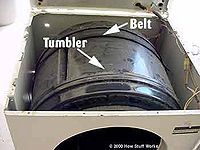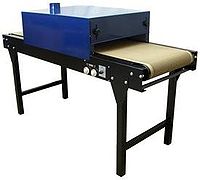Belt Dryers
The Belt Dryers are machines which are used for continuous drying materials using hot gases or radiation.
Working principle
A Belt dryer is a device designed for the particularly gentle thermal treatment of product. The wet product is continuously and evenly applied through an feed chamber onto a perforated belt. The belt, predominantly in horizontal position, carries the product through the drying area which is divided into several sections. In these cells drying gas flows through or over the wet product and dries it. Each cell can be equipped with a ventilating fan and a heat exchanger. This modular design allows the drying and cooling temperatures to be controlled separately in the different sections. Thus, each dryer cell can be individually controlled and the drying / cooling air flow can be varied in each cell. In addition, the speed of the conveyor belt can be varied what gives an additional parameter for setting of drying time. The cells can be heated or cooled directly or indirectly, and all heating media, such as oil, steam, hot water or hot gas can be used.
Design features
Belt dryers / Belt Coolers are designed in modular system. Each belt dryer consists of infeed head, conveyor belt and discharge end. Different kinds of dryers are possible to construct, e.g.
- Single-belt dryer
- Multi Stage Dryers
- Multi-level dryer
- Multi-belt dryer
Ventilation options
In general there are two ways of gas flow pattern. The drying air can flow, according to the treatment process, either through or over the product.
Exemplary conveyor options
- Chain-guided wire mesh conveyor
- Chain-guided hinge slat conveyor
- Chain-guided steel plate conveyor
- Chainless wire mesh conveyor
Feeding variations
- Granulating mill – filter cake or amorphous and paste-like products respectively
- Slewing belt conveyor – sensitive and free flowing products
- Distribution spiral
- Rotatable arm feeding device – stable products
- Plates feeding
Typical applications
Belt dryers are predominantly used in the following industries:
- Chemical Industry
- Pharmaceutical industry
- Food and feeding-stuff industry
- Non-metallic minerals industry
- Plastics industry
- Wood industry
Video

